|
Foster's Raid, aka Goldsboro Expedition: A North Carolina Civil War History
"Two days before the battle of Fredericksburg, [Union] General Foster
left New Bern, N.C., with a force of 10,000 infantry, 6 batteries, having all 40 pieces of artillery, and 640 cavalry...After
the engagement, General Foster withdrew his troops and returned to New Berne (present-day New Bern). The total Federal losses
during the "Goldsboro Expedition," aka Foster's Raid, were 592 killed and wounded. The total Confederate loss, as reported
by General Smith, was 339."
| The Civil War Goldsboro Expedition Map |
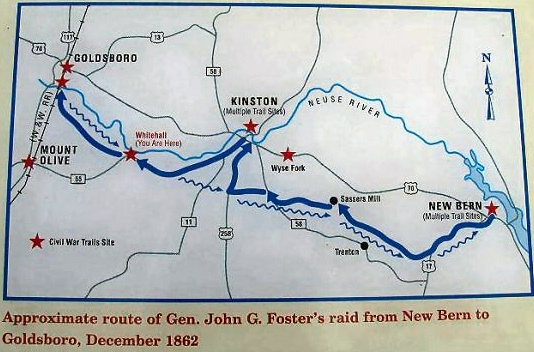
|
| Also known as Foster's Raid (From New Bern to Goldsboro) |
| General John G. Foster |
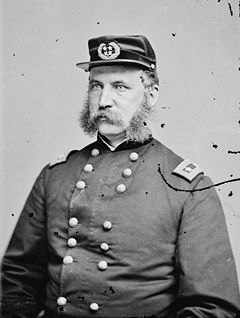
|
| (May 22, 8123 - September 2, 1874) |
General Foster with 5,000 men left Washington, N.C., for Williamston, on
the 2nd of November 1862. At Little Creek and at Rawls' Mill, spirited resistance to his advance was offered by the Confederates,
and Foster lost 6 killed and 8 wounded. The Confederates, however, were not in force enough to do more than retard Foster's
movements.
Captain Newkirk, of the cavalry, and Captain Adams, commanding a section
of artillery, attacked and destroyed the Union gunboat Ellis on the New River. According to General Whiting's report, this
affair was very creditable to the officers and men engaged.
On December 10th, Lieutenant Colonel John C. Lamb, with some companies from
the Seventeenth North Carolina, a squadron of cavalry under Colonel Evans, and Moore's Battery, captured for a time the town
of Plymouth, N.C. Colonel Galloway gives the following account of the adventure:
"The plan was to capture the pickets and take the place by surprise. We
reached the picket station just before day, captured all but one, who escaped, firing his musket as he ran. This gave notice
of our approach, and when we reached Plymouth, a body of Federals were seen formed across the main street ready to receive
us. The cavalry was ordered to charge these men, which was done in good style and full allowance of the 'rebel yell.' The
enemy fired one volley and broke in all directions. Some escaped to the gunboats in skiffs, some hid, some took to the houses
and fired from the windows. Quite a lively cannonade ensued between he gunboats and our battery." (Captain Galloway and three
privates were wounded.)
| Kinston Bridge, North Carolina, Civil War |
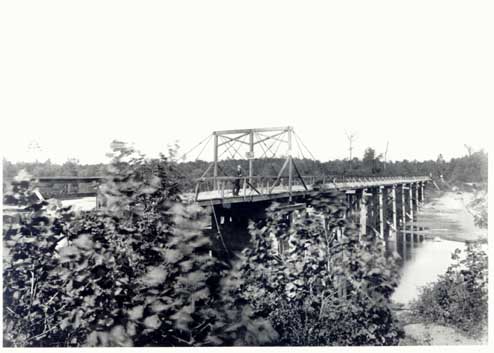
|
| Photograph Courtesy William Garrison Reed, New Bern-Craven County Public Library |
| Goldsboro Expedition |
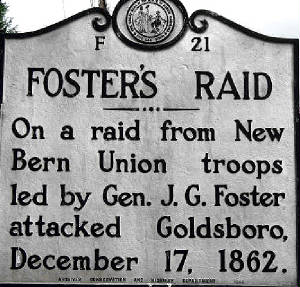
|
| (Historical Marker) |
Two days before the battle of Fredericksburg, General Foster left New
Bern, N.C., with a force of 10,000 infantry, 6 batteries, having all 40 pieces of artillery, and 640 cavalry.
On the 13th, Foster had reached Southwest Creek, not far
from Kinston. The
Confederates had destroyed the bridge, and Colonel Radcliffe's Sixty-first North Carolina Regiment was posted on the west
side to delay Foster's advance. The Ninth New Jersey and Wessell's Brigade crossed over the creek, and after an engagement
of about an hour, General N. G. Evans, commanding the Confederates, was obliged to withdraw. He took position on the Neuse
River, about two miles from Kinston bridge. General Evans had, to oppose Foster's 10,000 men, the Seventh, Twenty-second,
and Holcombe's Legion, all South Carolina volunteers; in addition, he had the Sixty-first North Carolina Regiment, Mallett's
North Carolina Battalion, and Boyce's South Carolina Regiment, and Starr's and Bunting's North Carolina batteries--in all
2014 men.
While Evans was moving from the creek to the river, a fleet of small gunboats
that had come up from New Bern to attack the works at Kinston, under Commander Murray, endeavored to get in reach of the works.
Owing to low water, only one of the boats, the Allison, came into action, and Colonel S. D. Pool's battalion of heavy artillery
soon drove it back.
On the 14th, General Evans, with his South Carolina on the left and the
North Carolinians under Radcliffe on the right, awaited Foster's attack.
| Union and Confederate Army Positions at White Hall |
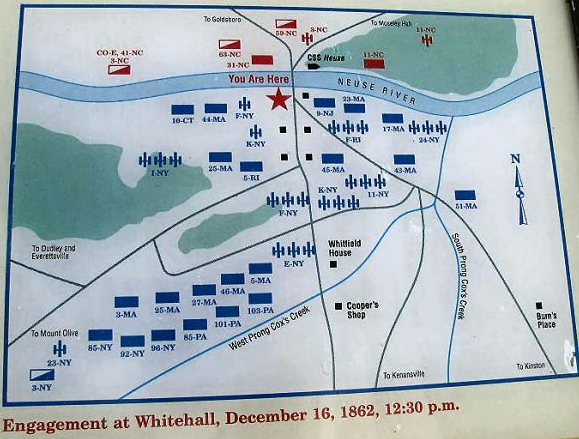
|
| Battle of White Hall Map of the Union and Confederate Armies |
| North Carolina Civil War Map |

|
| (Click to Enlarge) |
Foster sent in Wessell's brigade and batteries, supporting Wessell's by
Armory's brigade and then by Stevenson's brigade. The odds were, of course, too great for Evans, and after two and a half
hours of stubborn contention he was forced back across the bridge, and followed so closely that at the crossing 400 of his
men were captured. Evans reformed his broken lines, and was joined by the Forty-seventh North Carolina, which had just arrived,
under Colonel S. H. Rogers.
General Foster sent a demand for the surrender of the Confederates but,
of course, Evans promptly declined compliance. General Evans retreated to Falling Creek. General Foster did not pursue, but
recrossed the river and continued toward Goldsboro. On arriving at White Hall, eighteen miles from Goldsboro, General Foster
found the bridge burned and General B. H. Robertson of General Evans' command, posted on the opposite bank of the river ready
for battle. General Robertson, having under his command the Eleventh North Carolina (aka Bethel Regiment), Colonel Leventhorpe;
the Thirty-first, Colonel Jordan; 600 dismounted cavalry from Ferrebee's and Evans' regiments; and a section of Moore's Battery,
under Lieut. N. McClees, had been sent to burn the bridge and dispute Foster's crossing should he attempt to rebuild the bridge.
General Foster sent forward the Ninth New Jersey Regiment, followed by Amory's brigade, and eight batteries took position
on the river bank. A heavy artillery and infantry fired commence at 9:30 on the 16th. General Robertson says in his report:
"Owing to a range of hills on the White Hall side, the enemy had the advantage
of position. The point occupied by his troops being narrow; not more than one regiment at a time could engage him. I therefore
held Leventhorpe, Ferrebee and Evans in reserve, leaving the artillery [two pieces], Thirty-first regiment, and two picked
companies in front. The cannonading from the enemy's batteries became so terrific that the Thirty-first regiment withdrew
from their position without instruction, but in good order. I immediately ordered Colonel Leventhorpe forward. The alacrity
of with which the order was obeyed by his men gave ample proof their gallant bearing, which they so nobly sustained during
the entire fight....The conduct of his regiment reflects the greatest credit upon its accomplished and dauntless commander."
| Location of the Battle of Goldsboro Bridge |
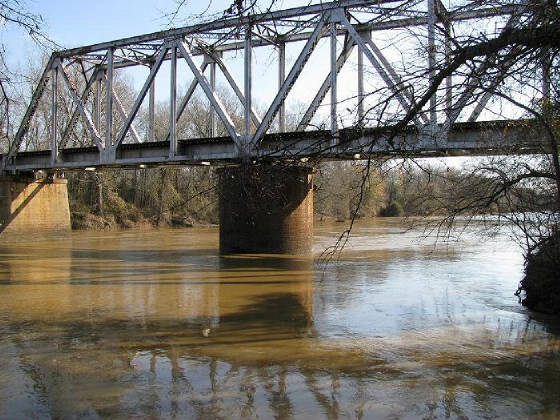
|
| Civil War Battle of Goldsboro, NC |

The two guns of McClees were no match for the many batteries across the
Neuse River, but he served them with coolness and gallantry. Captain Taylor, of Foster's signal service, reported that the
fire from the Eleventh North Carolina was "one of the severest musketry fires I have ever seen." Colonel W. J. Martin, historian of the Eleventh regiment, says
of the conduct of his regiment:
"Posted along the river bank, from which another regiment had just been
driven back, it was pounded for several hours at short range by a terrific storm of grape and canister, as well as musketry;
but it never flinched, and gained a reputation for endurance and courage which it proudly maintained to the fateful end."
| North Carolina Civil War Railroad Map |
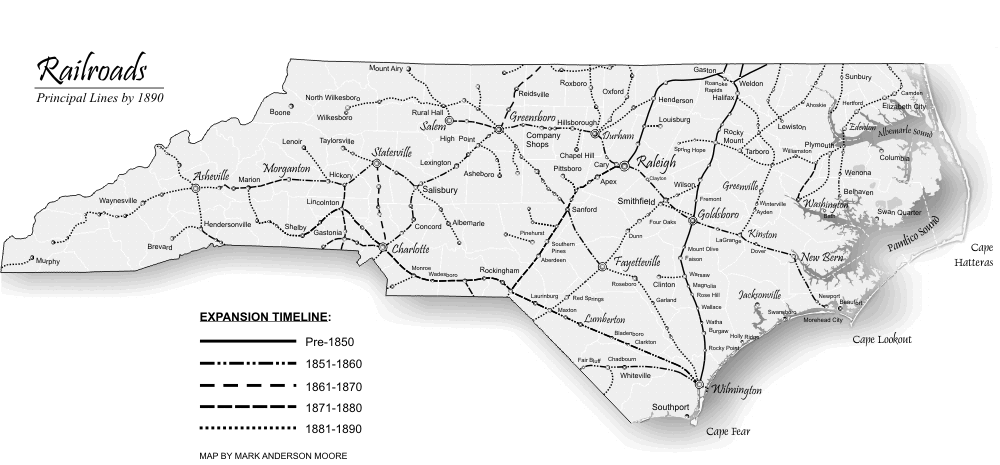
|
| (Click to Enlarge) |
The Eleventh regiment that thus distinguished itself was the first regiment
organized in North Carolina, and it was well known as the "First North Carolina." It was also known as the "Bethel Regiment,"
because it had fought at the first land battle of the Civil War. (The first engagement was known as the Battle of Big Bethel
and also the Battle of Bethel Church, and it witnessed the first Confederate soldier killed.) General Robertson reported his
loss at 10 killed, 42 wounded. The Federal loss was 8 killed and 73 wounded.
After his brush with Robertson, Foster moved on toward Goldsboro, his main
objective being to burn the railroad bridge there. At and near the bridge were stationed General Clingman, with the Eighth, Fifty-first and Fifty-second North Carolina Regiments, under Colonels H. M. Shaw, W. A. Allen and J. K.
Marshall; Companies B, G, and H, Tenth artillery, acting as infantry, and Company P, Fortieth artillery, acting as infantry,
under Lieut. Col. S. D. Pool; and Starr's Battery. Other troops were in the vicinity, but for reasons not now apparent, were
not moved to the bridge in time to assist the men engaged. The Sixty-first regiment, Lieutenant Colonel Devane, arrived on
the field during the engagement and reported to its brigadier, General Clingman, in time to take part in the afternoon action.
| Civil War Battle of Goldsboro, North Carolina |
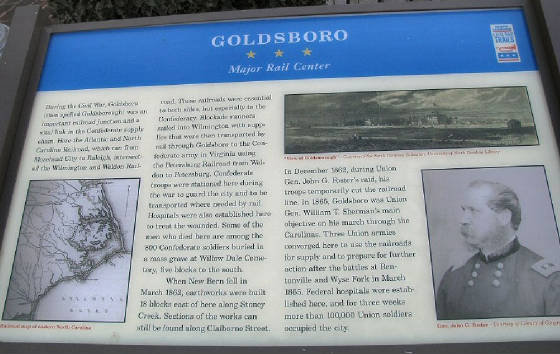
|
| (Click to Enlarge) |
| US Senator and Confederate General |
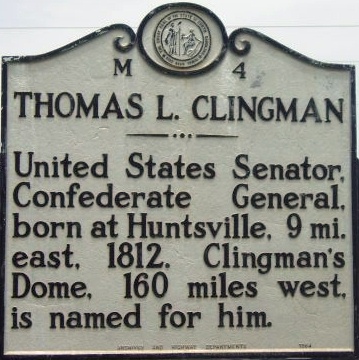
|
| (Historical Marker) |
When General Foster reached a point near Goldsboro, he ordered five regiments
to move down the railroad track and burn the bridge. A regiment was sent with them to protect the flank. General Wessell's
brigade was advanced, to be in supporting distance of the advance. The Federal regiments and artillery attacked promptly.
All the Federal artillery seems, according to Foster's report, to have engaged at the bridge. The attack fell principally
on the Fifty-first and Fifty-four regiments on the south side of the bridge. Starr's two pieces opened. The two regiments
were unable to hold their own, broke, were reformed by General Clingman, and ten driven back to the county bridge.
As these regiments were in retreat, Lieut. George A. Graham, of the Twenty-third New York Battery, dashed gallantly forward, and in spite
of the efforts of Pool's men to reach him with their rifles, set fire to the bridge.
General G. W. Smith reported that Clingman's regiments fell back, Gen. N.
G. Evans arrived on the field with his South Carolina brigade, and assumed command. By his direction, the Fifty-first and
Fifty-third, supported by Evans' Holcombe Legion, made a charge against H. C. Lee's brigade, of which that officer said:
"A portion of the enemy instantly with loud cheers, charged up the hill
toward the battery, and bore up steadily in the face of a well-directed and most destructive fire... The enemy, meanwhile,
had been staggered by the crushing fire of the batteries, and at sight of my supporting regiments, broke and fled in disorder
to the woods. His retreat was covered by a heavy fire from the battery on his right, which inflicted on my command a loss
of 3 killed and 19 wounded."
| General Foster's Raid |
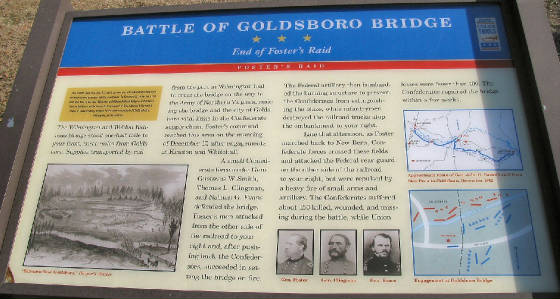
|
| (Click to Enlarge) |
This "battery" as Colonel Lee calls it, was one gun of Lieut. T. C. Fuller's
section of Starr's; the other gun was overturned. Lieutenant Fuller acted with great coolness, and showed a soldier's aptitude
for finding and striking his enemy. General Clingman said of the determined manner in which Fuller fought his solitary gun:
"Lieutenant Fuller with the greatest gallantry continued to reply until darkness put an end to the contest." Captain Reinhardt's
company of the Third regiment of cavalry is warmly commended in the report of Colonel Stevens.
After the afternoon engagement, General Foster withdrew his troops and returned
to New Berne. The total Federal losses during the "Goldsboro Expedition," aka Foster's Raid, were 591 killed and wounded.
The total Confederate loss, as reported by General Smith, was 339. The North Carolina losses, with the exception of the Sixty-first
regiment, which there is no report, were 40 killed and 177 wounded. (Depending on the source, however, the casualty numbers
vary.)
*D. H. Hill, Jr., son of Confederate Lieutenant General Daniel Harvey Hill,
Sr., was the author of Confederate Military History Of North Carolina: North Carolina
In The Civil War, 1861-1865 -- which is a welcome addition to the North Carolina Civil War buff. North
Carolina native Daniel Harvey Hill, Sr. -- commonly referred to as D. H. Hill -- was one of only two lieutenant
generals from the Tar Heel State. (Lieutenant general was the second highest rank in the Confederate Army.) Hill was
also brother-in-law to the renowned "Stonewall" Jackson.
Recommended
Reading: Confederate Military History Of North Carolina:
North Carolina In The Civil War, 1861-1865.
Description: The author, Prof. D. H. Hill, Jr., was the
son of Lieutenant General Daniel Harvey Hill (North Carolina
produced only two lieutenant generals and it was the second highest rank in the army) and his mother was the sister to General
“Stonewall” Jackson’s wife. In Confederate Military History Of North
Carolina, Hill discusses North Carolina’s massive task of preparing and
mobilizing for the conflict; the many regiments and battalions recruited from the Old
North State; as well as the
state's numerous contributions during the war. Continued below...
During Hill's
Tar
Heel State study, the reader begins with
interesting and thought-provoking statistical data regarding the 125,000 "Old
North State" soldiers that fought
during the course of the war and the 40,000 that perished. Hill advances with the Tar Heels to the first battle at Bethel, through numerous bloody campaigns and battles--including North Carolina’s
contributions at the "High Watermark" at Gettysburg--and concludes with Lee's surrender at
Appomattox.
Goldsboro Expedition,
aka Goldsborough Expedition [December 1862]
Advance to:
Recommended Reading: The Civil War in North Carolina.
Description: Numerous battles and skirmishes were fought in North Carolina during the Civil War, and the campaigns and battles themselves were crucial
in the grand strategy of the conflict and involved some of the most famous generals of the war. John Barrett presents the
complete story of military engagements across the state, including the classical pitched battle of Bentonville--involving
Generals Joe Johnston and William Sherman--the siege of Fort
Fisher, the amphibious campaigns on the coast, and cavalry sweeps such
as General George Stoneman's Raid.
Recommended Reading: The Civil War in the Carolinas (Hardcover). Description: Dan Morrill relates the experience of two quite different states bound together in
the defense of the Confederacy, using letters, diaries, memoirs, and reports. He shows
how the innovative operations of the Union army and navy along the coast and in the bays and rivers of the Carolinas
affected the general course of the war as well as the daily lives of all Carolinians. He demonstrates the "total war" for
North Carolina's vital coastal railroads and ports. In
the latter part of the war, he describes how Sherman's operation
cut out the heart of the last stronghold of the South. Continued below...
The author
offers fascinating sketches of major and minor personalities, including the new president and state governors, Generals Lee,
Beauregard, Pickett, Sherman, D.H. Hill, and Joseph E. Johnston. Rebels and abolitionists, pacifists and unionists, slaves
and freed men and women, all influential, all placed in their context with clear-eyed precision. If he were wielding a needle
instead of a pen, his tapestry would offer us a complete picture of a people at war. Midwest Book Review: The Civil War in the Carolinas by civil war expert and historian Dan
Morrill (History Department, University of North Carolina at Charlotte, and Director of the Charlotte-Mecklenburg Historical
Society) is a dramatically presented and extensively researched survey and analysis of the impact the American Civil War had
upon the states of North Carolina and South Carolina, and the people who called these states their home. A meticulous, scholarly,
and thoroughly engaging examination of the details of history and the sweeping change that the war wrought for everyone, The
Civil War In The Carolinas is a welcome and informative addition to American Civil War Studies reference collections.
Recommended Reading:
The Civil War on the Outer Banks: A History of the Late Rebellion Along the Coast of
North Carolina from Carteret to Currituck With Comments on Prewar Conditions and an Account of (251 pages). Description: The ports at Beaufort, Wilmington, New Bern and Ocracoke, part
of the Outer Banks (a chain of barrier islands that sweeps down the North Carolina coast from the Virginia Capes to Oregon
Inlet), were strategically vital for the import of war materiel and the export of cash producing crops. From official
records, contemporary newspaper accounts, personal journals of the soldiers, and many unpublished manuscripts and memoirs,
this is a full accounting of the Civil War along the North
Carolina coast.
Recommended Reading: Storm over Carolina: The Confederate
Navy's Struggle for Eastern North Carolina. Description: The struggle for control of the eastern waters of North Carolina during the War Between the States was a bitter, painful,
and sometimes humiliating one for the Confederate navy. No better example exists of the classic adage, "Too little, too late." Burdened
by the lack of adequate warships, construction facilities, and even ammunition, the South's naval arm fought bravely and even
recklessly to stem the tide of the Federal invasion of North Carolina from the raging Atlantic. Storm Over Carolina is the account of the
Southern navy's struggle in North Carolina waters and it
is a saga of crushing defeats interspersed with moments of brilliant and even spectacular victories. It is also the story
of dogged Southern determination and incredible perseverance in the face of overwhelming odds. Continued below...
For most of
the Civil War, the navigable portions of the Roanoke, Tar, Neuse, Chowan, and Pasquotank rivers were
occupied by Federal forces. The Albemarle and Pamlico sounds, as well as most of the coastal towns and counties, were also
under Union control. With the building of the river ironclads, the Confederate navy at last could strike a telling blow against
the invaders, but they were slowly overtaken by events elsewhere. With the war grinding to a close, the last Confederate vessel
in North Carolina waters was destroyed. William T. Sherman
was approaching from the south, Wilmington was lost, and the
Confederacy reeled as if from a mortal blow. For the Confederate navy, and even more so for the besieged citizens of eastern
North Carolina, these were stormy days indeed. Storm Over Carolina describes their story, their struggle, their history.
Recommended Reading: Gray Raiders of the Sea: How Eight Confederate Warships Destroyed
the Union's High Seas Commerce. Reader’s Review: This subject is one
of the most fascinating in the history of sea power, and the general public has needed a reliable single-volume reference
on it for some time. The story of the eight Confederate privateers and their attempt to bring Union trade to a halt seems
to break every rule of common sense. How could so few be so successful against so many? The United
States, after Great Britain,
had the most valuable and extensive import/export trade in the world by the middle of the 19th century. The British themselves
were worried since they were in danger of being surpassed in the same manner that their own sea traders had surpassed the
Dutch early in the 18th century. Continued below…
From its founding
in 1861, the Confederate States of America realized it had a huge problem since it lacked a navy.
It also saw that it couldn't build one, especially after the fall of its biggest port, New
Orleans, in 1862. The vast majority of shipbuilders and men with maritime skills lived north of the
Mason-Dixon Line, in the United States, and mostly in New
England. This put an incredible burden on the Confederate Secretary of the Navy, Stephen R. Mallory. When he saw
that most of the enemy navy was being used to blockade the thousands of miles of Confederate coasts, however, he saw an opportunity
for the use of privateers. Mallory sent Archibald Bulloch, a Georgian and the future maternal grandfather of Theodore Roosevelt,
to England to purchase British-made vessels
that the Confederacy could send out to prey on Union merchant ships. Bulloch's long experience with the sea enabled him to
buy good ships, including the vessels that became the most feared of the Confederate privateers - the Alabama,
the Florida, and the Shenandoah. Matthew Fontaine Maury
added the British-built Georgia, and the Confederacy itself launched the
Sumter, the Nashville, the Tallahassee,
and the Chickamauga - though these were generally not as effective
commerce raiders as the first four. This popular history details the history of the eight vessels in question, and gives detailed
biographical information on their captains, officers, and crews. The author relates the careers of Raphael Semmes, John Newland
Maffitt, Charles Manigault Morris, James Iredell Waddell, Charles W. Read, and others with great enthusiasm. "Gray Raiders"
is a great basic introduction to the privateers of the Confederacy. More than eighty black and white illustrations help the
reader to visualize their dramatic exploits, and an appendix lists all the captured vessels. I highly recommend it to everyone
interested in the Confederacy, and also to all naval and military history lovers.
Recommended Reading:
The Civil War in Coastal North Carolina (175 pages) (North Carolina Division
of Archives and History). Description: From the drama
of blockade-running to graphic descriptions of battles on the state's islands and sounds, this book portrays the explosive
events that took place in North Carolina's coastal region during the Civil War. Topics discussed include the strategic
importance of coastal North Carolina, Federal occupation
of coastal areas, blockade-running, and the impact of war on civilians along the Tar Heel coast.
Recommended Reading: Ironclads and Columbiads: The Coast (The Civil War in North Carolina)
(456 pages). Description: Ironclads and Columbiads
covers some of the most important battles and campaigns in the state. In January 1862, Union forces began in earnest to occupy
crucial points on the North Carolina coast. Within six months,
Union army and naval forces effectively controlled coastal North Carolina from the Virginia line south to present-day Morehead
City. Union setbacks in Virginia, however, led to the withdrawal of many
federal soldiers from North Carolina, leaving only enough Union troops to hold a few coastal strongholds—the vital ports
and railroad junctions. The South during the Civil War, moreover, hotly contested the North’s ability to maintain its
grip on these key coastal strongholds.
|

